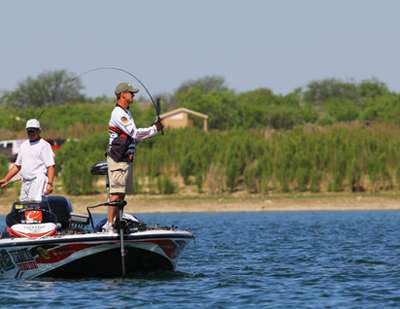
After bass have done their annual spring fling, the postspawn fish seek out a cozy place to rest and dine for a while. Whenever he fishes lakes lacking standing timber or aquatic vegetation, Edwin Evers searches for spawned-out bass hanging around boat docks, which is usually the first piece of cover the fish are drawn to when they leave the spawning pockets and flats.
Bass are attracted to the docks because they provide an abundance of shade that cools down the water and offer plenty of objects for the fish to suspend under and around, such as boat hoists, crossbars and personal watercraft lifts.
The docks also attract baitfish, which are easy for bass to ambush in the shady areas. The Oklahoma pro favors running a dock pattern for postspawn bass on lakes with stained water (visibility of 1 to 3 feet). "The best docks will be in major spawning pockets, and I like them to be in fairly deep water," says Evers, who favors floating docks in which the back end of the pier sits in 10 feet of water and the front end could be over depths of 40 to 50 feet.
Algae buildup on a boathouse matters more to Evers than the dock's type of floatation. "I've caught fish on the black plastic floats and the old Styrofoam floats," Evers says. "It seems like the shad spawn on the older docks, and they feed on the algae, so you definitely want to find some docks that have algae on the floats."
Since postspawn bass tend to suspend under the floatation, Evers selects a couple of lures that run just below the surface to stay in the strike zone. His top choice is a white Bass Pro Shops Lazer Eye spinnerbait with tandem blades (gold Colorado and silver willow leaf) and a 1/0 XCalibur trailer hook. He opts for either a 3/8- or 1/2-ounce model, depending on the depth of the fish under the dock.
The five-time BASS winner pitches his blade bait along the sides of the dock or into the boat wells and employs a stop-and-go retrieve. "I try to keep my lure as close to the foam as I can and bring it right out (to the boat)," says Evers. "There are times when the fish are going to be on the cross beams (inside the dock wells), so sometimes I like to knock those cross members with my lure."
If his spinnerbait fails to produce, Evers switches to a white 3/8-ounce Booyah Swim'n Jig that he matches with a white Yum Muy Twintail plastic grub. He makes this combination look more compact by trimming the skirt of his jig. "I just use a real quick retrieve about a foot under the water," says Evers, who adds action to his jig-and-grub combo by bouncing his rod tip throughout the presentation.
Evers' tackle for both lures consists of a 7-foot, medium-heavy action Bass Pro Shops Qualifier XPS Rod and Bass Pro Shops Pro Qualifier baitcast reel (6.4:1 gear ratio) filled with 20-pound Bass Pro Shops XPS Fluorocarbon Signature Series line. Running docks produces for Evers whether the skies are blue or gray. "I don't think it matters much; if they are on that pattern, they are on it," Evers says. "It works really well in the morning, but this tactic will also work throughout the entire day."
Evers favors the dock pattern during the postspawn because it produces both quality and quantity. "I have caught 40 to 50 fish a day doing this," says Evers. And despite targeting bass that just finished a drastic weight reduction process, Evers has relied on the docks to bag 18- to 20-pound limits in tournaments.
Originally published March 2011





